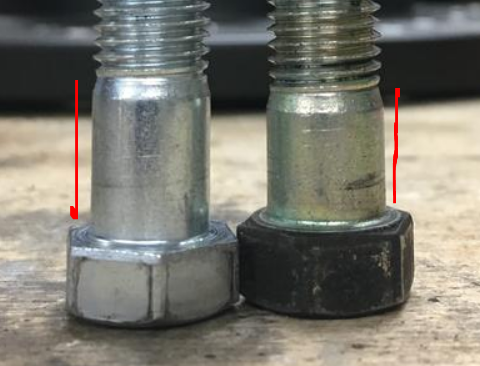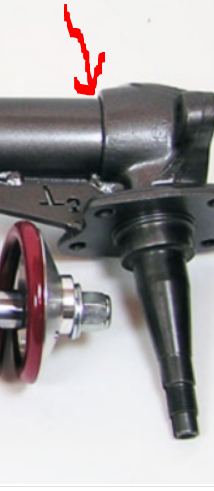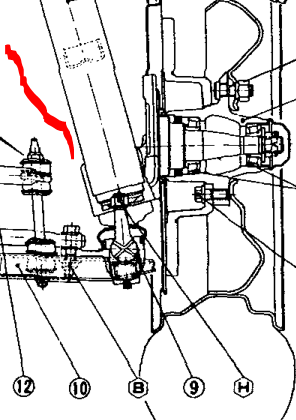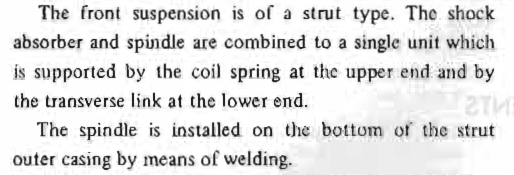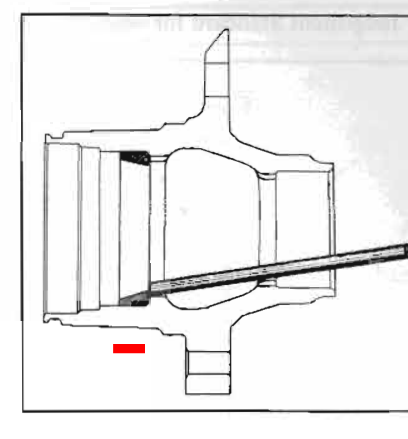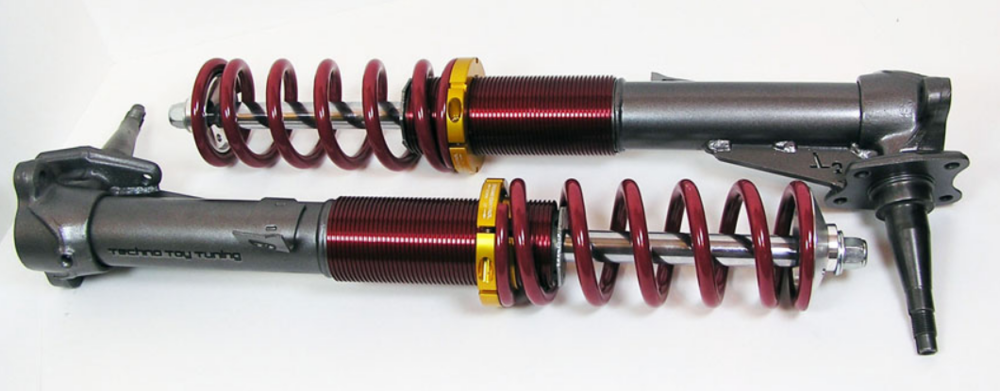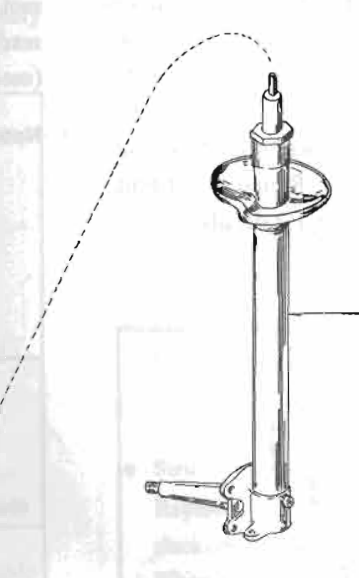Zed Head
Free Member
-
Joined
-
Last visited
-
Currently
Viewing Topic: It only works if I spray gas into the air intake.
Everything posted by Zed Head
-
front suspension and tire clearance problem
-
1970 240z Opinions on value
-
1973 Rebuild
Thread locker. You could leave out the split lock washer entirely.
-
1973 Rebuild
I'd be more concerned about the shank bottoming out. Easy to check though. A flat washer under the lock washer might solve both problems. With a dab of thread locker to be sure. Would make it look like the original as far as the functional bits.
-
front suspension and tire clearance problem
The strut is a tube pressed in to a casting. Actually I might be wrong on the welding. They say that the spindle is attached to the "casing" then welded. Might be a translation error. Maybe the tube is just a press fit. Can't be sure. But that's where you want to look closely. The bottom drawing is from 1976 because it's more clear.
-
front suspension and tire clearance problem
The fact that you got a change in that gap, to me, says that the base and tube joint is loose. It's supposed to be rigid, you shouldn't have been able to make it move at all. I'd get the angle right and have it rewelded. Maybe add a gusset like T3 does. Even if it doesn't fall off it's going to move while you're driving. Probably break eventually. I would not "leave it". Grab the top of the wheel and shake it or just shove the front of the car side to side and see if the gap changes. Maybe it will just fall apart and you'll have an easy decision. You should be able to see a clean gap at the intersection of the tube and casting, at the bottom, where the tube is moving in the casting. Use a bright light and take a look.
-
[SOLD] 1973 Datsun 240Z Scarab
Congratulations. Maybe the new owner will show up here. Or not, considering.
-
[SOLD] 1973 Datsun 240Z Scarab
This is not appropriate for this site. You should chill out.
-
[SOLD] 1973 Datsun 240Z Scarab
Maybe I'm not the target. I just saw your other post TimN. Why are you even here? 2 posts and you were in somebody's face from the first one. Why don't you provide links to what you know?
-
front suspension and tire clearance problem
The spindle that the bearings and wheel sit on are welded to the tube. At this point I think that you're looking for the cause of the damage. Here is an interesting picture from T3 showing the structure, but with a reinforcing gusset added. Maybe they know something. The only other possibility, it seems, is deep seated bearings. https://technotoytuning.com/nissan/240z/front-coilover-conversion-datsun-240z
- [SOLD] 1973 Datsun 240Z Scarab
-
front suspension and tire clearance problem
I think that the hub casting is slipped over the end of the tube then welded on. Maybe it's falling off. Worth a close look.
-
front suspension and tire clearance problem
The super quick not much thought required test is to swap the wheels. The problem will follow the wheel or stay with the strut.
-
l24 blocked engine build - Few Questions
Woops. Didn't know "Kameari" referred to the whole list. The stock gear is adjustable. Also didn't realize there were so many Kameari parts. There's even a mustache bar. I seem to recall people having problems in the past with the Kameari ignition system because it has no instructions. Should be fun to get running once assembled. Motorsport is behind the times with their search results but if you put the right word in a lot of stuff comes up. http://www.thezstore.com
-
l24 blocked engine build - Few Questions
OR http://www.thezstore.com/page/TZS/PROD/classic12f02/10-2042
-
front suspension and tire clearance problem
Has it ever rolled? Not clear what the history of the car is. If the wheels are the same and the hubs correctly assembled with bearings then the strut is bent or broken. Or you have mismatched wheels. Did you get one of your backs on the front and they have different offsets?
-
front suspension and tire clearance problem
Did you forget to put the bearings in the hub? (I actually did that once on a different model of car). Something odd happening. That relationship is all tied to the strut alone.
-
l24 blocked engine build - Few Questions
The general thoughts about these engines, from the guys that have built a few, is that the big power increases are all released by work on the head. Apparently the intake ports are the main constriction. So the cam and the RPM potential won't be available unless you get the head ported. The fine details of squish and getting oddly specific pistons to work won't matter without head work. As I understand things. But, the standard 15% correction indicates that you'll need about 180 HP at the crankshaft. So, not terrible, seems achievable, from what I've read. Your path seems somewhat convoluted I guess, to me. It seems like flat tops, a worked head, some high RPM parts, and a cam might get you there. I don't really get the need for the domes and the crank offset work. Anyway, I think that Diseazd is the guy who destrokes his engines to get high RPM screamers. He has built several. He would know more, he can shoot me down. I'm just a words on the page guy at this point. Good luck. @Diseazd
-
New engine
Any dyno numbers yet? Read all of the pages. @Diseazd
-
[SOLD] 1973 Datsun 240Z Scarab
This is the basic problem of "no paperwork". Can't tell where it came from. If you could get even some old letters or find some scribble marks in the engine bay, it would add a lot. Some rednecks do fine work too.
-
[SOLD] 1973 Datsun 240Z Scarab
Ahhh...memories of beating a dent in the shock towers with a small sledge so the 351 Cleveland would fit in to the little Ford Futura engine bay. Good times... It was a barn though, not a shed.
-
l24 blocked engine build - Few Questions
You listed 240+240 crank, then L28 crank. E31 head then "worked head" with no casting numbers. Domed pistons and squish. Then you implied that I had not read what you wrote, like it was all clearly described. You have a big list of parts that might or might not work well together. You can't use all of the parts you listed in the same engine. That's what I meant by conflicting. I'm not really in to numbers matching that much, but a modified engine isn't really original, to me. It's either as it came from the factory or it's as it was modified twenty years ago. Time capsule style. I'd pull the numbers matching engine and hop up an L28. Then you achieve both goals.
-
Stalling issue(under throttle)
That's a cheap gauge, with no damping. The needle bounce is amplified. Probably not a big deal to the carbs. Hard to tell what real pressure is, but it looks about 4.5 to 5 psi. An oil-filled gauge will give a smoother reading.
-
l24 blocked engine build - Few Questions
I read. You wrote a lot of conflicting things. Still seems like much work, getting all of the parts and operations to fit together properly, just to keep the numbers matching. If you modify the block is it really original? Good luck.
-
l24 blocked engine build - Few Questions
I'm not an engine builder by any means. But it seems like you're spending a lot of money on minor operations and odd parts just to create a fairly typical L6 engine. Looks like a common L6 with ~10:1 CR, and a Schneider 290F cam. And you're only getting 2.6 liters of displacement. Adding 0.5 mm of stroke (expensive machining operation), then decking the block (expensive machining operation) to get piston height right seems drastic for not much, doesn't it? How will these "domed" pistons (expensive) fit the combustion chamber? If they're not flat tops then you'll have to have the combustion chamber shaped exactly to the piston (expensive) to properly use "squish". An L28 might be a better starting point. Just another internet opinion.






